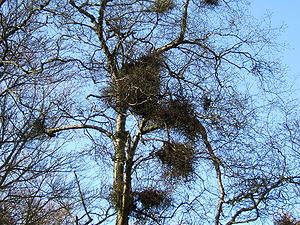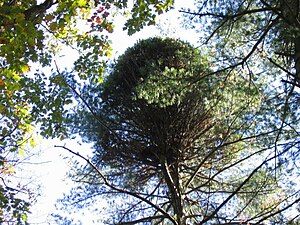


Witch's broom or witches' broom is a deformity in a woody plant, typically a tree, where the natural structure of the plant is changed. A dense mass of shoots grows from a single point, with the resulting structure resembling a broom or a bird's nest. It is sometimes caused by pathogens.
Diseases with symptoms of witches' broom, caused by phytoplasmas or basidiomycetes, are economically important in a number of crop plants, including the cocoa tree Theobroma cacao,[1] jujube (Ziziphus jujuba)[2] and the timber tree Melia azedarach.[3]
- ^ Purdy, L.H.; Schmidt, R.A. (1996). "Status Of Cacao Witches' Broom: Biology, Epidemiology, and Management". Annual Review of Phytopathology. 34 (1): 573–594. doi:10.1146/annurev.phyto.34.1.573. PMID 15012557.
- ^ Li Yun; Wang Yu; Tian Yanting & Sun Haoyuan (2001). "Advances in Tissue Culture and Eliminating of the Pathogeny of Witch Broom Disease(MLO) of Chinese Jujube". Archived from the original on 2021-04-26. Retrieved 2013-08-08.
{{cite journal}}: Cite journal requires|journal=(help) - ^ Gomez, G.G.; Conci, L.R.; Ducasse, D.A.; Nome, S.F. (1996). "Purification of the Phytoplasma Associated with China-tree (Melia azedarach L.) Decline and the Production of a Polyclonal Antiserum for its Detection". Journal of Phytopathology. 144 (9–10): 473–477. doi:10.1111/j.1439-0434.1996.tb00327.x.